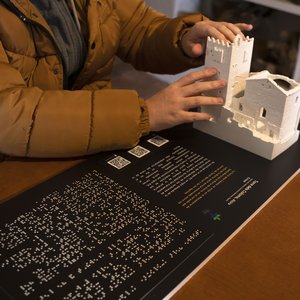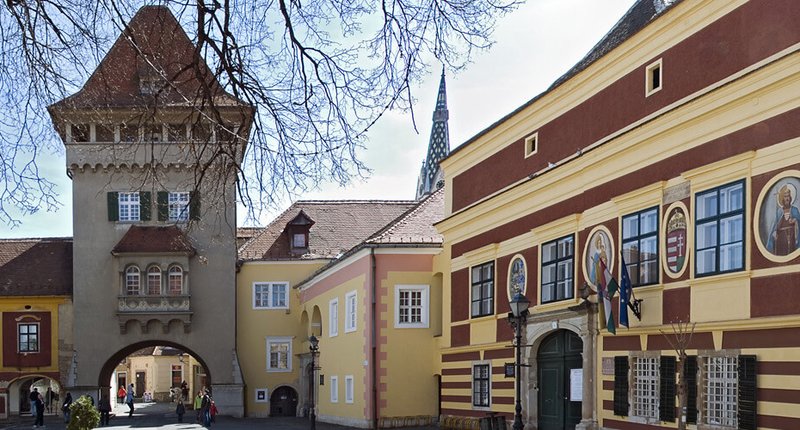
Authors: Lorena Pardo and AD&D 4D
They say that when you go blind the universe comes in front of you and shouts in your ear that you are just stardust, and it is because sight helps us to become aware of our dimension before the cosmos. If you are blind from birth, like David Ramirez, journalist and Councillor for Accessibility of the City Council of Requena, the notion of the dimension of "me before the world" is even more complex to assimilate.
3D printing of cultural, archaeological and architectural heritage from a photogrammetric model is an important step towards giving a faithful vision of the world to blind and partially sighted people. It is not a question of a scale model, which has been around for years, but of faithful models in textures, layers and even sensations that arouse the curiosity of those who explore them and generate the desire to visit the place physically.
Davíd Ramírez told us about his experience of observing with his touch three architectural monuments in his region, the Torre de Alfarp, the Torre dels Coloms (Alzira) and the Torre de Antella, all of them printed in 3D. The models were also documented in Braille, which helped him to become aware of the value of the heritage he was going to visit without relying on his sense of sight. "It is a unique opportunity for hyperrealism, not only of the scale volume of the buildings, but also of their textures, because you can perceive the intersections of the terrain, the ruins, the restored parts and their different layers," adds David. As a blind person, he had previously enjoyed models that did not have the reality component that these new 3D tools offer. "It is the possibility of making me aware of my volume in front of the world, in this case for the three towers, but it is a powerful tool for anyone, because it brings the heritage closer, it shows it to you without moving from home with all its value and that enjoyment generates the desire to go deeper and get to know it in its original location", he tells us after his experience.
These new three-dimensional technologies from photogrammetry and applied to heritage open up a new approach to experiential tourism and break down barriers of remoteness or inaccessibility that cultural heritage often presents.
These techniques, according to David, could be applied to all areas of life, not just buildings, because they involve a real knowledge of things that speeds up intuition, so it would have an important place in schools where experiential models can replace memorising (the culture of repetition). It is a means of access for people with sensory disabilities and also an important instrument for a society that is moving towards collaboration and a more empathetic attitude towards people's different abilities.
David was able to experience the towers through a series of resources that enable users to see, touch and even hear with the help of mobile devices. On the one hand, these expose a series of physical elements (graphic and tactile) that facilitate understanding of the phenomenon to be treated in a first contact, and on the other a set of accessible digital resources that expand the information using new information technologies.
The elements are:
The dimensions of the base surface and the layout of the elements were designed to facilitate haptic exploration process using both hands if required. Accessing from the front the 3D tactile model is on the left, the Braille code on the right and the text in large type between. This layout provides for access with both hands simultaneously - the dominant hand, usually the right hand, accessing the Braille code in relief, while the other hand accesses the model.
Regarding the tactile 3D model itself, its three-dimensional geometry has been made from a digital data acquisition by photogrammetry. The data has then been treated to prepare the digital model by Rapid Prototyping (RP) techniques, in this case Additive Manufacturing (AF), popularly known as 3D Printing. The 3D model was then printed using the Fused Deposition Modeling (FDM) technique, with the polymer Polylactic acid (PLA) for its base body and a surface finish of thermosetting resins to consolidate it, facilitate maintenance and cleaning, enhance the volume to the sense of sight, smooth the layers produced by the FDM technique and contrast to the touch certain areas of the volume.
Finally a set of audiovisual resources (in different languages) were made available by including QR codes on the base/support itself. These provide information about the towers on a PDF with links to websites, including a subtitled video for each 3D tactile model and links to the 3D digital model online. The PDF files are created in a way that allows it to be accessed using a speech reader to vocalise the text and in this way enables access not only for visually impaired people but also for people with hearing disabilities.
These resources take advantage of the wide possibilities provided by the Internet and its free access tools, to present the contents of the towers from various perceptual modalities and facilitate access by the largest number of people,regardless of their sensory abilities.
The designed set opens a door for all those people who are interested in tour architectural heritage. It represents a way of exploring how to improve the dissemination and interpretation of our cultural heritage while trying not to leave behind any group of people.

Illustration from Oculus artificialis teledioptricus sive Telescopium, 1685
“The art, science and technology of obtaining reliable information about physical objects and the environment, through processes of recording, measuring, and interpreting imagery and digital representations of energy patterns derived from noncontact sensor systems” American Society for Photogrammetry and Remote Sensing (ASPRS)
https://guides.archaeologydataservice.ac.uk/g2gp/Photogram_1-1
https://sketchfab.com/blogs/community/how-to-set-up-a-successful-photogrammetry-project